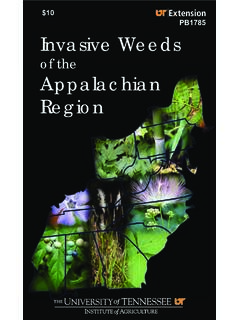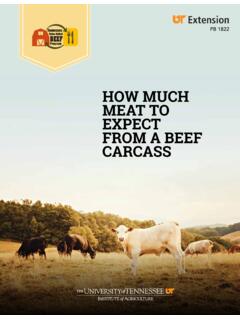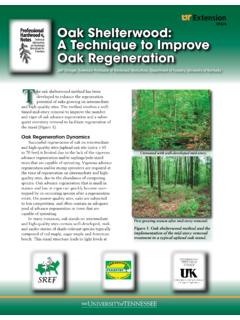Transcription of Common Herbicides for - University of Tennessee Extension
1 W245. Common Herbicides for Fruit and Vegetable Weed Control Greg Armel, Extension Horticultural Weed Specialist Beth Babbit, Extension urban Horticulture Area Specialist This chart provides recommendations for the best treatments available for weed control in most vegetable crops. The rates and recommendations for these Herbicides are specific for fruit, vegetable and other edible crops, and the chart should be used in accordance with the label. Herbicides listed in this chart are Common and often easy for consumers to find; there are many other acceptable Herbicides on the market that may suit a similar purpose.
2 Always consult the label before applying any pesticide on a specific crop or crop cultivar. Products applied for burndown of existing vegetation prior to planting and/or post-directed for weed control around existing vegetable and fruit crops. Extreme care should be taken to avoid spray contact on the foliage of desired vegetation. Preemergence and/or pre-plant applied Herbicides for residual control of weeds in selected edible crops. Postemergence selective weed control in specific vegetable crops. Products applied for burndown of existing vegetation prior to planting and/or post-directed for weed control around existing vegetable crops in organic production systems.
3 Extreme care should be taken to avoid spray contact on the foliage of desired vegetation. 1. Chemical Vegetables appearing on label Weeds controlled Timing of Application Application rates Burndown Glyphosate Many crops; see label for specifics. A non-selective herbicide Pre-plant applications 1 to 5 pints/acre or Trade name: Roundup , that controls many allowed in most plants. 1 to 10% solutions, other weeds. Post-directed and spot depending on the crop spray treatments are allowed for certain crops Surfactant requirements as long as care is taken are based upon to avoid contact with any formulation of foliage or green tissue.
4 Glyphosate selected. Consult label product Please consult labels for more specific label for specific information. recommendations. Glyphosate has no soil residual activity. Pelargonic acid Asparagus, artichoke, beet, carrot, A non-selective herbicide Post-directed (avoiding 3 to 10% solution (spot Trade name: Scythe , other parsnip, potato, radish, sweet potato/ that controls many spray on foliage or spray): yam, turnip, rutabaga, garlic, onion, weeds. green bark) and pre- leek, shallot, celery, cilantrol, cress, plant applications in all 3-5%- solution for endive, lettuce, parsley, rhubarb, landscape trees, bedding annual weeds spinach, broccoli, Brussels sprouts, plants, flowers and other 5-7%- solution for cabbage, cauliflower, collards, kale, ornamentals.
5 Perennial weeds kohlrabi, greens (mustard and turnip), 8-10%- Solution for eggplant, okra, pepper (chili, bell, sweet), Pelargonic acid has no soil maximum burn down of pimento, tomato, cucumber, gourd, residual activity. mature weeds muskmelon, cantaloupe, pumpkin, squash, watermelon, apple, pear, apricot, No additional adjuvant cherry, nectarine, peach, plum, prune, required. blackberry, blueberry, dewberry, grape, strawberry, grape and other fruits and vegetables 2. Preemergence And/Or Pre-plant Trifluralin Many vegetable crops and non-bearing Several annual grasses, Preemergence weed 1 lb / 400 sq ft for heavy Trade name: Preen tree fruit and nuts carpetweed, chickweed, control when applied to clay soils Garden Weed Preventer Florida pusley, goosefoot, garden vegetables 2 to *Not labeled for preemergence henbit, knotweed, 3 inches tall but before 1 lb / 960 sq ft for applications in cucurbit crops.
6 Lambsquarters, pigweed weeds have emerged. medium loam soils species, purslane However, application methods may differ with 1 lb / 1280 sq ft for light specific crops. This sandy soils product needs immediate incorporation after application with irrigation, rainfall or light tillage. Trifluralin Many vegetable crops and non-bearing Several annual grasses, May be applied prior to 1 to 2 pints/acre Trade name: Treflan 4L, tree fruit and nuts carpetweed, chickweed, planting or transplanting depending on crop and Treflan EC, etc. Florida pusley, goosefoot, most vegetable crops.
7 Soil type (fine textured *Not labeled for preemergence henbit, knotweed, Immediate incorporation soils require the highest applications in cucurbit crops. lambsquarters, pigweed is necessary for optimal recommended rate, species, purslane control. See label for more while coarse-textured details. soils require the lowest recommended rate). Pendimethalin Carrots, sweet corn, edible beans, garlic, Several annual grasses, Pre-plant incorporated or to 4 pints/acre Trade Name: Prowl H20 grain sorghum, lentils, mints, onions, carpetweed, chickweed, preemergence applications depending on crop and peas, potato, sunflower and other Florida pusley, henbit, prior to planting or soil type (fine-textured vegetables ladysthumb, Common transplanting vegetable soils require the highest lambsquarters, pigweed crops.)
8 Postemergence recommended rate, species, purslane, spurge applications can be made while coarse-textured in certain crops but weed soils require the lowest control is dependent on recommended rate). applying prior to weed emergence. DCPA Broccoli, Brussels sprouts, cabbage, Several annual grasses, Pre-plant or preemergence 6 to 14 pints/acre or 4. Trade name: Dacthal , cauliflower, all Brassica leafy vegetables, lambsquarters, weed control to 5 fl oz/1 to 2 gallons other cantaloupe/honeydew/watermelons carpetweed, chickweed, (treats 1000 sq ft.
9 (not preemergence but 3- to 5- leaf; do purslane, field pansy not incorporate), onions, radish (from and suppression of other preemergence up to 3-leaf stage), sweet broadleaf weeds potato, strawberry, tomato/tomatillos/. eggplant (4 to 6 weeks after transplanting or 4 to 6 inch tall seedling). 3. Corn gluten meal- All vegetable crops Certain annual grasses Preemergence weed 5 to 10 lbs/250 sq ft. active ingredient: several and black medic, black control when applied to dipeptides nightshade, buckhorn garden vegetables 2 to Trade name: Preen plantain, catchweed 3 inches tall but before Organic Vegetable Garden bedstraw, clover, weeds have emerged.
10 Re- Weed Preventer*, other curly dock, dandelion, apply every 4 to 6 weeks lambsquarters purslane, as needed. redroot pigweed * Not registered for certified organic production use. 4. Postemergence Selective Weed Control Sethoxydim apricot, asparagus, beans (dry, Provides selective Provides selective to pints/acre Trade name: Poast , other succulent), beets, broccoli, Brussels postemergence contact postemergence contact (depending on crop). sprouts, cabbage, cauliflower, collards, control of several grass grass control only. garlic, kale, kohlrabi, leeks, mustard/ species including, but not Sethoxydim has little to no Add 1% v/v crop oil rape greens, cantaloupe, cucumber, limited to, bermudagrass, soil residual activity.










